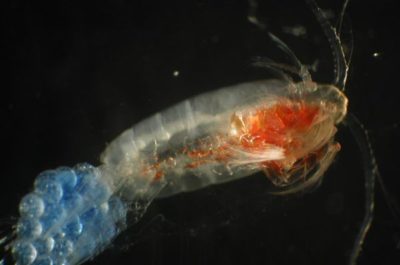
What is plankton? And what is a copepod!? Plankton refers to a group of organisms that are not able to swim against the current. The word plankton comes from the Greek word planktos, which means wanderer or drifter. These organisms are composed of plant-like plankton called phytoplankton, and animal plankton called zooplankton. They are the foundation for the food chain in the ocean as phytoplankton contribute a great deal of oxygen during photosynthesis, and zooplankton are a major food source for other animals.
You might be more familiar with copepods than you think! If you have ever seen Spongebob Squarepants, the character Plankton is actually based on a copepod. These one-eyed crustaceans have long antennae and an exoskeleton (skeleton on the outside of its body) and are virtually transparent. The word copepod comes from the Greek kope- meaning oar, and poda- meaning foot, “oar-footed,” because of how the swimming legs of the copepod move together. While there are said to be up to 13,000 species of copepods, they can range in size from .2mm up to 10mm in length. They are the most plentiful multi-celled animals in water and species thrive in extreme water temperatures and altitudes, from freshwater, to benthic to ocean environments. The planktonic marine copepods are a type of zooplankton called a holoplankton, which means that they stay planktonic for their entire life.
It is also believed that about half of the species of copepods are parasitic, and use bony fish, sharks, marine mammals, and invertebrates as a host. To avoid predation, copepods vertically migrate through the water column and sink deeper into the water during the day, but will come closer to the surface at night to feed. Copepods mostly feed on phytoplankton, but some larger species will feed on smaller species of zooplankton. Copepods are even thought to help control human diseases like malaria because they eat mosquito larvae.
Copepods are a major source of protein for our ocean animals, and therefore are a chief contributor to ocean stability. Because they are common plankton in the ocean, they are sure to turn up when collecting a plankton sample, and so fun to look at under the microscope!
Written By: Jaclyn Lucas


